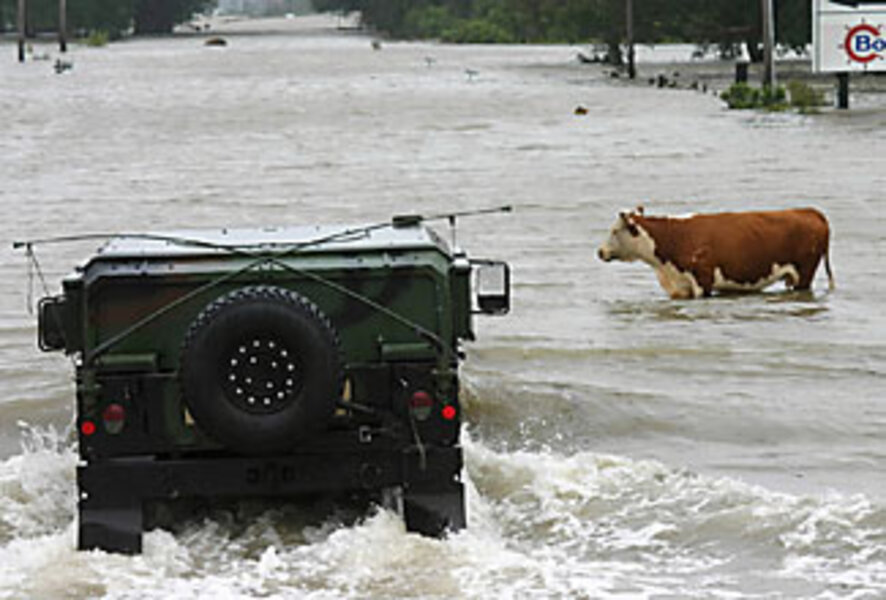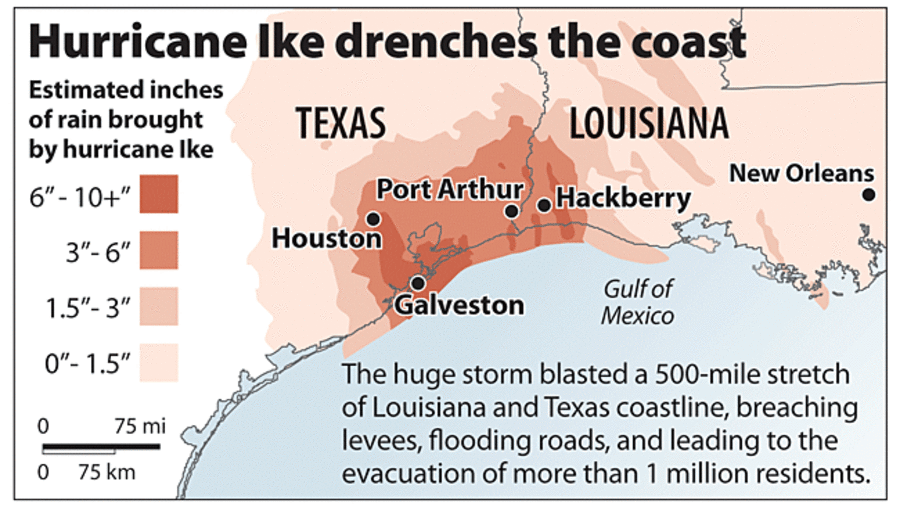In Ike's wake, holdouts complicate rescues
Loading...
| HACKBERRY, La.
A convoy of National Guard trucks – flanked by Louisiana Dept. of Wildlife airboats and "Cajun special" flat-bottomed boats – pressed toward this small cattle town, fighting precarious winds, rough chop, and a snake-infested flood to reach hundreds of holdout farmers and roughnecks, many with no intention of getting rescued.
"About 300 stayed in Hackberry," says irritated Robert Swire, Cameron Parish sheriff's deputy, who is manning a checkpoint where Highway 27 disappeared under water some 20 miles from the Gulf. "They shouldn't have done that."
Hurricane Ike devastated much of Galveston, popped windows out of Houston high-rises, and left as many as 5 million people without power on its way to becoming what President Bush called "a major disaster."
But as the storm slowly crawled northward, rescue and relief crews faced a formidable task: Surveying more than 2,000 square miles of newly created sea in lower Louisiana and along the Sabine Pass on the Texas border, dotted with dozens of small towns, hamlets, and settlements.
While some 2.3 million people in Texas and Louisiana evacuated, more than 100,000 are estimated to have refused voluntary and mandatory evacuation orders along Ike's 200-mile surge zone.
Thankfully, there were few injury and fatality reports as the federal government led a massive rescue and relief effort that included Coast Guard reconnaissance helicopters, dozens of airboats, and massive National Guard assets ranging from inflatable Zodiac boats to Humvees, as well as thousands of troops.
By Sunday, the Category 2 hurricane had been downgraded to a tropical depression. Still, some 2.5 million people in the two states were left without electrical power, officials said, and it could be weeks before some regain power.
Despite storm preparations, many independent-minded residents in Louisiana's low-lying cattle, oil, and shrimp country refused to abandon their homes, even as the massive floodwaters surged into the upper bayous.
While Department of Homeland Security Secretary Michael Chertoff chided residents for staying, the truth on the ground was ambiguous. Despite stern warnings, many people were simply surprised by the massive surge.
"This was much worse than Rita, water wise," said Ken Wagner of the 256 Infantry Combat Brigade of the Louisiana National Guard. "It became very challenging for people. It also carried a lot of risk" for rescuers.
From Orange County, Texas, to Cameron County, La., the US Coast Guard, National Guard units, and the US Fish and Wildlife Service conducted over 1,000 rescues, but were turned back as often as not by residents determined to hang on as the worst floodwaters since 1913 clung to the Cajun prairie.
Setting out into a dangerous chop in a small flatboat, wildlife agent Robbie Mayo acknowledged the risks his crews faced as they motored into open water toward Hackberry. The danger of capsizing was significant, especially as hurricane-force winds still lashed what were once open fields. "There's just so much water, and there's three-foot waves."
Coming off his deployment to hurricane Gustav two weeks ago, National Guard Spc. Thanh Le epitomized the peculiar blurring of rescuer and victim that has come to symbolize the Gulf's recent spate of hurricanes. Some of the National Guard soldiers deploying Saturday still had to fix their own storm-damaged homes.
Specialist Le – a sushi chef in civilian life – signed up for the National Guard after fleeing New Orleans during hurricane Katrina, fed up with images of looting and determined to not feel like a victim again.
"We'll go 24 hours, we're ready!" the lanky Le shouted enthusiastically as he piloted Charlie Company's two-ton personnel carrier down Highway 27.
Forging flooded highways toward Hackberry, ready to take on dozens of residents, they encountered confused cows, soaked rats, and hundreds of homes and trailers completely flooded in what had become a macabre sight: The view of the Gulf's salty waves encroaching nearly 20 miles onto what was once dry land. "Water, water everywhere," muttered former Marine Corps officer Sgt. Peter Legle.
The convoy motored nearly 10 miles into the flooded areas, ending up at a "lily pad" staging point – an abandoned refinery – just outside of Hackberry.
But the carrier remained empty as boat operators reported that most residents stuck in the flood were staying. "These are the most self-sufficient people in the country," said Sergeant. Legle.
"It's frustrating sometimes, but I understand where they're coming from," he said.
Agent Mayo encountered dozens of people who refused rescue. Generators were running, and many residents were watching TVs on the top floors, even attics, of their homes. "They told me, 'Come back tomorrow and I might be ready to go,'" says Mayo. "I told them we might not be back, but they were undeterred."
Agents pulled out about 75 people from the Hackberry area, including an elderly couple who had tried to flee in a small boat but had become entangled by the wind in a tree. Clutching two bags and a small mutt, the couple said they'd lost all their chickens and cattle. The husband thanked every National Guardsman he met.
At a staging point in Carlyss, La., along the major north-south road into coastal Cameron Parish, local farmers motored through the floods in a tractor, returning from moving cows to higher ground. Still, many cows remained standing neck deep in water, they said.
One resident had waded through the waters to release two chained dogs that had been left behind. Some who had fled began to realize the extent of the damage. "Our house is gone," said evacuee Tina Lyons.
Hackberry resident Darren East, his shirt soaked, came in on a rescue boat as a pale sun sank across the flooded prairie. "We sat around watching TV and listening to the news, and then we saw the water getting higher and higher," he said. "It was a little hectic."
Seventy-five people remained in Hackberry overnight, joining thousands of others determined to ride out the floods that clung to the Texas-Louisiana border. Attempts to get them out resumed Sunday morning, as rescuers across the region went back to work. The relief effort could last two weeks, said Legle.






